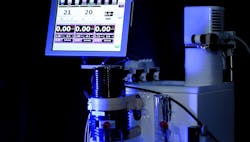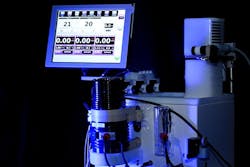Reactor Makes Light Work of Alkane Conversion
Researchers at Eindhoven University of Technology (TU/e), Eindhoven, the Netherlands, have developed a method for immediately converting gaseous, low-molecular-weight alkanes including methane, ethane, propane and isobutane to more complex compounds. The reaction occurs in a continuous-flow photoreactor at room temperature using a decatungstate catalyst being irradiated with a 365-nm light source.
“While the activation of liquid alkanes with decatungstate has been known about for many years, the activation of gaseous alkanes is much more challenging,” says Tim Noël, associate professor with the micro flow chemistry and synthetic methodology group in TU/e’s department of chemical engineering and chemistry.
Achieving success, he adds, requires addressing two fundamental problems: prohibitively high bond dissociation energies of C-H bonds in gaseous alkanes, which makes them very tough to activate, and the technological challenges of bringing them into contact with a photocatalyst.
The new reaction also avoids the extreme conditions currently needed to activate the C-H bonds in liquid alkanes, later purification steps and associated byproducts.
The researchers carried out 38 different reactions between light alkanes and olefins. Conversion levels varied from 56.7% to 97.6% and yields from 47.9% to 91.5%. An article in a recent issue of Science provides details.
“The maximum capacity of the reactor we have got to so far is 15 mL. However, this is a commercially available reactor that can be scaled by a factor of ten — which would lead to production of 10–20 g/hr under current conditions,” explains Noël.
He believes a rotor-stator spinning disk reactor (RS-SDR) that the group currently is developing could produce better results.
Figure 1. Conversion of gaseous alkanes to more complex compounds occurs at room temperature. Source: Timothy Noël, Eindhoven University of Technology.
“The advantage of this reactor is that it provides highly intensified mass transfer between the gas and the liquid phase. As we have shown for a singlet oxygen reaction, this not only leads to high yields in short reaction times but also to increased selectivity, i.e., excellent process optimization. We anticipate that similar results are feasible for methane/ethane/propane activation.”
The RS-SDR has a capacity of 64 mL, which eventually should enable 1 kg/d production by the end of 2022.
Noël’s team also is looking for catalysts that can activate C-H bonds in the visible light spectrum. “Sources such as LED technology are much cheaper and more energy efficient,” he notes.
He anticipates a great deal of interest from industry in the new technology once the team demonstrates that the chemistry involved can be scaled.

